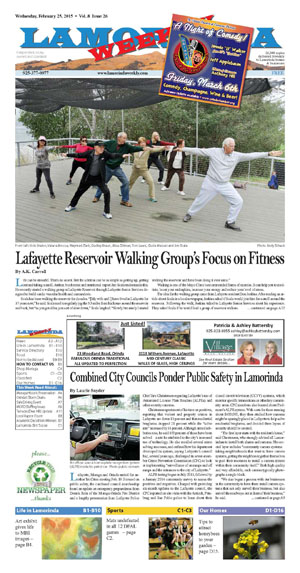|
|
Published Februray 25th, 2015
|
Combined City Councils Ponder Public Safety in Lamorinda
|
|
| By Laurie Snyder |
|
|
Lafayette, Moraga and Orinda united for another Tri-Cities meeting Feb. 19. Focused on public safety, the combined council membership heard an update on emergency preparedness from Dennis Rein of the Moraga-Orinda Fire District and a lengthy presentation from Lafayette Police Chief Eric Christensen regarding Lafayette's use of Automated License Plate Readers (ALPRs) and other security cameras.
 Christensen spent most of his time on positives, reporting that violent and property crimes in Lafayette are down 19 percent and that residential burglaries dropped 21 percent while the "solve rate" increased by 33 percent. Although armed robberies rose, he said 100 percent of those have been solved - a rate he attributed to the city's increased use of technology. He also recalled several crime solving successes, and outlined how his department developed its system, saying Lafayette's council had, several years ago, challenged its seven-member Crime Prevention Commission (CPC) to look at implementing "surveillance of on ramps and off ramps and the entrances to the city of Lafayette."
Christensen spent most of his time on positives, reporting that violent and property crimes in Lafayette are down 19 percent and that residential burglaries dropped 21 percent while the "solve rate" increased by 33 percent. Although armed robberies rose, he said 100 percent of those have been solved - a rate he attributed to the city's increased use of technology. He also recalled several crime solving successes, and outlined how his department developed its system, saying Lafayette's council had, several years ago, challenged its seven-member Crime Prevention Commission (CPC) to look at implementing "surveillance of on ramps and off ramps and the entrances to the city of Lafayette."
 ALPR testing began in July 2013, followed by a January 2014 community survey to assess the positives and negatives. Charged with providing six-month updates to the Lafayette council, the CPC reported on site visits with the Antioch, Pittsburg and San Pablo police to learn about their closed circuit television (CCTV) systems, which monitor specific intersections or other key community areas. CPC members also learned about Piedmont's ALPR system. With costs for those running about $600,000, they then studied how cameras might be sparingly placed in Lafayette to help solve residential burglaries, and decided three layers of security should be created.
ALPR testing began in July 2013, followed by a January 2014 community survey to assess the positives and negatives. Charged with providing six-month updates to the Lafayette council, the CPC reported on site visits with the Antioch, Pittsburg and San Pablo police to learn about their closed circuit television (CCTV) systems, which monitor specific intersections or other key community areas. CPC members also learned about Piedmont's ALPR system. With costs for those running about $600,000, they then studied how cameras might be sparingly placed in Lafayette to help solve residential burglaries, and decided three layers of security should be created.
 "The first layer starts with the resident's house," said Christensen, who strongly advised all Lamorindans to install both alarms and cameras. The second layer includes "community camera systems - taking neighborhoods that want to have camera systems, getting the neighbors together themselves to pool their resources to install a camera system within their community itself." Both high quality and very affordable, each camera typically photographs a single block.
"The first layer starts with the resident's house," said Christensen, who strongly advised all Lamorindans to install both alarms and cameras. The second layer includes "community camera systems - taking neighborhoods that want to have camera systems, getting the neighbors together themselves to pool their resources to install a camera system within their community itself." Both high quality and very affordable, each camera typically photographs a single block.
 "We also began a process with our businesses in the community to have them install camera systems that not only surveil their business, but also surveil the roadways out in front of their business," he said. Running data obtained from high resolution cameras through ALPR devices, some Lafayette businesses can now "actually go through and record license plates themselves for vehicles that come up to their business or go by their business out on the roadway."
"We also began a process with our businesses in the community to have them install camera systems that not only surveil their business, but also surveil the roadways out in front of their business," he said. Running data obtained from high resolution cameras through ALPR devices, some Lafayette businesses can now "actually go through and record license plates themselves for vehicles that come up to their business or go by their business out on the roadway."
 Finally, said Christensen, are the "neighborhood camera systems which create that third layer of security, which are what you've heard about - the motion-activated cameras or the Reconyx cameras themselves. Every month we report to our Crime Prevention Commission about the use of the cameras, about the data we're using, about problems we've seen, about crimes that we've solved with it."
Finally, said Christensen, are the "neighborhood camera systems which create that third layer of security, which are what you've heard about - the motion-activated cameras or the Reconyx cameras themselves. Every month we report to our Crime Prevention Commission about the use of the cameras, about the data we're using, about problems we've seen, about crimes that we've solved with it."
 After early testing, said Christensen, it was easier to identify areas where crimes were occurring. In February 2014, they bought enough cameras to go through and surround those specific neighborhoods. "No one could get into and out of that neighborhood without us knowing," he said.
After early testing, said Christensen, it was easier to identify areas where crimes were occurring. In February 2014, they bought enough cameras to go through and surround those specific neighborhoods. "No one could get into and out of that neighborhood without us knowing," he said.
 "It seems to be enormously effective," said Moraga Vice Mayor Mike Metcalf, who asked about the expense. Christensen estimated that Lafayette has used roughly $70,000 for one portable and three mounted ALPR systems and $30,000 for the 40 Reconyx cameras scattered throughout Lafayette, plus the student worker who maintains those. In response to Orinda Vice Mayor Victoria Smith's query about cameras as deterrents, Christensen said he believes arrestees tell each other about the crime photos they're seeing in Lafayette's booking area.
"It seems to be enormously effective," said Moraga Vice Mayor Mike Metcalf, who asked about the expense. Christensen estimated that Lafayette has used roughly $70,000 for one portable and three mounted ALPR systems and $30,000 for the 40 Reconyx cameras scattered throughout Lafayette, plus the student worker who maintains those. In response to Orinda Vice Mayor Victoria Smith's query about cameras as deterrents, Christensen said he believes arrestees tell each other about the crime photos they're seeing in Lafayette's booking area.
 But some residents are concerned about Lamorinda's growing camera use. "Any information captured by Orinda ALPR readers, if we were to get them, would be shared, according to our police chief, with NCRIC - the Northern California Regional Intelligence Center," said Jack Paulus. "They then share this data with 15 surrounding counties who have a great many municipalities that have no privacy policies at all regarding this data.
But some residents are concerned about Lamorinda's growing camera use. "Any information captured by Orinda ALPR readers, if we were to get them, would be shared, according to our police chief, with NCRIC - the Northern California Regional Intelligence Center," said Jack Paulus. "They then share this data with 15 surrounding counties who have a great many municipalities that have no privacy policies at all regarding this data.
 "And the technology is prone to error," he said. "Because images are not always clear of obstructions - like fences and poles which appear like the number 1 in the scans. And false positives have led to innocent people being dragged out of their cars at gun point, such as Denise Green in San Francisco, which led to a huge lawsuit there - and to our own Ninth Circuit Court ruling that ALPR hits are insufficient evidence to even pull someone over."
"And the technology is prone to error," he said. "Because images are not always clear of obstructions - like fences and poles which appear like the number 1 in the scans. And false positives have led to innocent people being dragged out of their cars at gun point, such as Denise Green in San Francisco, which led to a huge lawsuit there - and to our own Ninth Circuit Court ruling that ALPR hits are insufficient evidence to even pull someone over."
 When asked by Karl Richtenberg how many innocent people had been pulled over and whether there had been any false arrests or any kind of physical inconvenience suffered by citizens due to the ALPRs, Christensen answered obliquely. He explained that when the inside-car ALPR activates, the police officer receives an auditory alert with a picture of a vehicle that the machine just scanned. "In our department in the sheriff's office, that doesn't create probable cause to stop the vehicle - and our policy's very clear about that. And so what the officer then has to do is go through and then to take and run the license plate itself, do a registration check, have dispatch come back and tell them that there is a reason to stop the vehicle." On redirect by Orinda Mayor Steve Glazer, Christensen added that ALPR devices are mounted only on city parking enforcement vehicles, which are not allowed to stop cars or detain people.
When asked by Karl Richtenberg how many innocent people had been pulled over and whether there had been any false arrests or any kind of physical inconvenience suffered by citizens due to the ALPRs, Christensen answered obliquely. He explained that when the inside-car ALPR activates, the police officer receives an auditory alert with a picture of a vehicle that the machine just scanned. "In our department in the sheriff's office, that doesn't create probable cause to stop the vehicle - and our policy's very clear about that. And so what the officer then has to do is go through and then to take and run the license plate itself, do a registration check, have dispatch come back and tell them that there is a reason to stop the vehicle." On redirect by Orinda Mayor Steve Glazer, Christensen added that ALPR devices are mounted only on city parking enforcement vehicles, which are not allowed to stop cars or detain people.
 Council members took no action since the Tri-Cities meeting was scheduled for informational purposes only. The Orinda City Council is tentatively scheduled to review the crime cam matter again at its first meeting in March.
Council members took no action since the Tri-Cities meeting was scheduled for informational purposes only. The Orinda City Council is tentatively scheduled to review the crime cam matter again at its first meeting in March.
 The reports and meeting recordings are available on the City of Orinda's website: www.cityoforinda.org.
The reports and meeting recordings are available on the City of Orinda's website: www.cityoforinda.org.

|
|
|
|
|
|
|
|
|
| |
|
|
|
|



